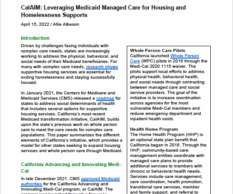Behavioral Health System Modernization: Comprehensive Approaches and Cross-Cutting Tools
NASHP
MARCH 22, 2024
As major purchasers, administrators, and regulators of behavioral health treatment and supports, states play a critical role in system transformation. Two states have pursued more innovative approaches and were highlighted in a NASHP report on increasing access to behavioral health care. See the full resource guide.












Let's personalize your content